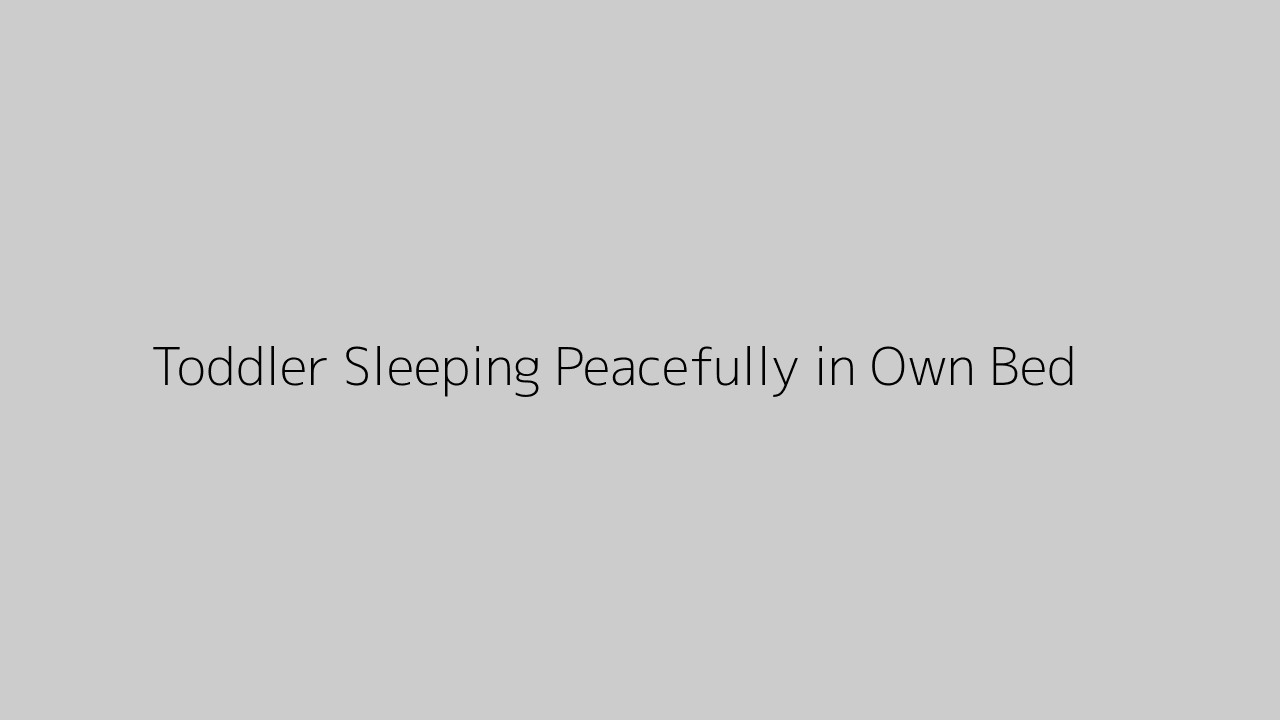Table of Contents
- Why is Independent Sleep So Important?
- Understanding Sleep Science: The Basics for Parents
- Laying the Foundation: Setting the Stage for Success
- Gentle Approaches to Teaching Independent Sleep
- Addressing Common Challenges & Troubleshooting
- Maintaining Progress & Long-Term Success
- When to Seek Professional Help
Promoting Independent Sleep: Unlocking Restful Nights for Your Child (and You!)
Ah, sleep. That elusive, precious commodity that often feels like a distant memory once you become a parent. If bedtime in your house feels more like a battleground than a peaceful transition, or if your nights are punctuated by frequent visits from a tiny human seeking comfort, you’re certainly not alone. The dream of a child who happily drifts off to sleep in their own bed and stays there all night? It might seem like a fairytale, but teaching independent sleep skills is achievable and incredibly beneficial for everyone involved.
But let’s be clear: promoting independent sleep isn’t about withholding love or comfort. It’s about empowering your child with the ability to self-soothe and navigate the natural ebbs and flows of sleep cycles on their own. It’s a vital life skill that fosters confidence, resilience, and, yes, leads to more consolidated, restorative sleep for the entire family. Ready to trade nighttime struggles for serene slumbers? Let’s dive into practical tips, gentle strategies, and the understanding needed to guide your child towards becoming a confident, independent sleeper.
Why is Independent Sleep So Important?
Beyond the obvious benefit of more sleep for exhausted parents, fostering independent sleep habits offers a wealth of advantages for your child’s development and overall family well-being.
Benefits for Your Child:
- Better Quality Sleep: Children who can fall asleep and fall *back* asleep on their own tend to link their sleep cycles more effectively, leading to longer stretches of deep, restorative sleep. This is crucial for growth, development, and immune function.
- Improved Daytime Functioning: Well-rested kids are generally happier kids! Sufficient sleep is directly linked to better mood regulation, improved concentration and learning in daycare or school, increased attention spans, and fewer behavioral challenges.
- Enhanced Confidence and Self-Soothing Skills: Learning to manage the transition to sleep and navigate brief night wakings without immediate intervention builds a child’s sense of competence and self-reliance. They learn they *can* handle it, which is a powerful feeling.
- Foundation for Lifelong Healthy Habits: The sleep skills learned in childhood often carry into adulthood. Teaching independent sleep sets the stage for a positive relationship with sleep long-term.
Benefits for Parents and Family:
- Reduced Parental Sleep Deprivation: This is a big one! Consistent, independent sleep for your child means more uninterrupted sleep for you, leading to improved physical health, mental clarity, and emotional resilience.
- Time for Reconnection and Self-Care: Predictable evenings where children settle independently free up valuable time for parents to connect with each other, pursue hobbies, or simply unwind.
- Less Stressful Evenings and Nights: Replacing bedtime battles and frequent night wakings with a smoother process significantly reduces stress and tension within the household.
- Improved Overall Family Harmony: When everyone is better rested, the entire family dynamic tends to improve. Patience levels are higher, interactions are more positive, and the home environment feels calmer.
Understanding Sleep Science: The Basics for Parents
Having a basic grasp of how sleep works can demystify the process and help you understand *why* certain strategies are effective.
Sleep Cycles & Waking
We all cycle through different stages of sleep throughout the night, moving between lighter and deeper sleep. It’s completely normal to partially awaken briefly between these cycles. Adults usually roll over and fall back asleep without even noticing. The challenge for some children is that they haven’t yet learned how to transition back to sleep without the specific conditions or assistance they had when they first fell asleep (like being rocked or fed). The goal of promoting independent sleep isn’t to prevent these natural brief wakings, but to equip your child to handle them calmly on their own.
Sleep Associations
A sleep association is essentially anything your child connects with the act of falling asleep. These can be positive and sustainable, or negative (or rather, unsustainable) in the long run.
- Positive Sleep Associations: These are cues that signal sleep but don’t require parental intervention. Examples include a dark room, a comfortable sleep sack, white noise, or a special lovie (for older babies/toddlers). These associations can be present all night long.
- Unsustainable Sleep Associations: These require active participation from a caregiver and become problematic when the child wakes mid-cycle and *needs* that specific action repeated to fall back asleep. Common examples include rocking to sleep, feeding to sleep, bouncing, holding, or a parent lying down with the child until they are fully asleep. While these methods often work initially, they can inadvertently create dependency.
Understanding your child’s current sleep associations is the first step towards gently shifting them towards more independent ones.
Age Appropriateness
Newborns have very different sleep needs and patterns. Their sleep cycles are shorter, and they genuinely need frequent feeding and closeness. Formal ‘sleep training’ is generally not recommended for infants under 4-6 months old, as their ability to self-soothe is still developing, and night feedings are often necessary. However, you can start laying a foundation early with routines and positive associations. Most gentle methods for promoting independent sleep are best suited for babies who are past the newborn stage (typically 6+ months) and toddlers or preschoolers who are developmentally ready to learn new skills.
Laying the Foundation: Setting the Stage for Success
Before you even think about specific sleep teaching methods, creating the right environment and routines is crucial. This foundation makes the transition to independent sleep much smoother.

The Power of the Bedtime Routine
Children thrive on predictability. A consistent bedtime routine acts as a powerful signal to their brain and body that sleep is approaching. It’s not just about getting tasks done; it’s about winding down and creating a sense of security.
- Why it Works: Routines reduce anxiety by making the process predictable. Each step becomes a cue, helping the child transition mentally and physically towards sleep.
- Key Elements: A good routine is calming and consistent. Think: a warm bath, putting on pajamas, brushing teeth, reading one or two quiet stories, a gentle song, and a final cuddle and kiss.
- Consistency is King: Aim to do the same steps, in the same order, at roughly the same time each night (even on weekends, as much as possible). This reinforces the sleep cues.
- Keep it Calm and Connected: The 20-30 minutes before bed should be screen-free and focused on quiet connection. Avoid stimulating activities or serious discussions.
- Short and Sweet: A routine doesn’t need to be elaborate. 20-30 minutes is usually sufficient.
Creating the Perfect Sleep Sanctuary
The environment where your child sleeps plays a significant role in their ability to fall asleep and stay asleep. Aim for optimal conditions:
- Darkness: Melatonin (the sleep hormone) production is triggered by darkness. Use blackout curtains to make the room as dark as possible, even for naps. Cover small light sources from electronics.
- Cool Temperature: A slightly cool room (around 68-72°F or 20-22°C) is generally considered ideal for sleep. Dress your child appropriately in layers rather than overheating the room.
- Quiet (or Consistent Sound): Minimize abrupt noises that could startle your child awake. Some families find a white noise machine helpful for masking household sounds and creating a consistent, soothing auditory environment. Ensure it’s kept at a safe volume and placed away from the crib/bed.
- Safe Sleep Space: Ensure the crib or bed adheres to current safety standards. For babies under one, the sleep space should be bare (no blankets, pillows, bumpers, or stuffed animals). Older toddlers can have a small blanket and perhaps a single, small comfort object.
- Comfortable & Uncluttered: Ensure the mattress is firm and comfortable. Keep the sleep space itself free from excessive toys or distractions. The bed should be for sleeping.
Daytime Habits Matter Too
Good sleep hygiene isn’t just about bedtime; it’s a 24-hour cycle.
- Age-Appropriate Naps: Overtiredness can ironically make it *harder* for children to fall asleep and stay asleep at night. Ensure your child is getting adequate daytime sleep for their age.
- Physical Activity: Plenty of active play during the day helps children burn off energy and sleep more soundly at night. Just avoid vigorous activity too close to bedtime.
- Natural Light Exposure: Exposure to natural light, especially in the morning, helps regulate the body’s internal clock (circadian rhythm).
- Balanced Nutrition: A healthy diet supports overall well-being, including sleep. Avoid sugary snacks or drinks and caffeine (found in chocolate, some sodas) close to bedtime. Ensure adequate hydration throughout the day.
Gentle Approaches to Teaching Independent Sleep
Once the foundation is set, you can choose a method to actively teach your child to fall asleep independently. It’s crucial to select an approach that aligns with your parenting philosophy and your child’s temperament. Remember, ‘gentle’ doesn’t necessarily mean ‘tear-free’ – change can be hard, and some protest is normal. The goal is to be responsive and supportive while guiding them towards the new skill of self-soothing.
Important Note: Always put your child down in their crib or bed **drowsy but awake**. This is the cornerstone of teaching independent sleep. They need to practice the skill of transitioning from awake to asleep without your direct intervention (rocking, feeding, etc.).

The Fading Method (Gradual Withdrawal)
This is often considered one of the gentlest methods, involving slowly reducing your presence and intervention.
- Start Close: After the bedtime routine, place your child in their crib/bed drowsy but awake. Sit in a chair right beside them. Offer occasional physical touch (patting, hand-holding) and verbal reassurance if needed, but try to minimize intervention.
- Gradual Retreat: Every few nights, move your chair slightly further away from the crib/bed, towards the door. Reduce physical touch first, relying more on your voice.
- Verbal Comfort Only: Once further away, offer only brief verbal reassurance if they fuss (e.g., “It’s okay, Mommy’s here, it’s time to sleep”). Avoid lengthy conversations.
- Exit Before Asleep: The final step is leaving the room while your child is still awake but calm, having moved your chair out completely.
Pros: Very gradual, high level of parental presence initially. Cons: Can take longer than other methods, requires significant patience.
Check-and-Console (Often associated with the Ferber method)
This method involves timed checks to reassure the child (and parent) without resorting to the old sleep associations.
- Put Down Awake: After the routine, put your child down drowsy but awake and leave the room.
- Timed Checks: If the child cries, wait a predetermined short interval (e.g., 3 minutes) before going in.
- Brief Reassurance: Keep the check brief (1-2 minutes). Offer calm verbal reassurance (“I love you, it’s time for sleep”) and maybe a gentle pat, but **do not pick the child up**.
- Leave Again: Leave the room even if the child is still crying.
- Increase Intervals: If crying continues, gradually increase the waiting intervals before the next check (e.g., 5 minutes, then 10 minutes, capping it at a level you’re comfortable with).
Pros: Structured, often works relatively quickly, child learns you will return but need to settle themselves. Cons: Involves parental leaving while child may be crying, which can be difficult for some parents.
Pick-Up/Put-Down
This method offers more physical comfort and may be suitable for younger babies or parents uncomfortable with leaving their child to cry for extended periods.
- Put Down Awake: Place your child in the crib drowsy but awake.
- Pick Up for Comfort: If they start crying intensely, pick them up and soothe them until they are calm.
- Put Down Calm but Awake: As soon as they are calm (but NOT asleep), put them back down in the crib.
- Repeat: Repeat this process as many times as needed until they fall asleep in the crib.
Pros: High level of physical comfort and responsiveness. Cons: Can be physically exhausting for parents, potentially stimulating for some babies, may take many repetitions initially.
Bedtime Routine Fading
This targets situations where a parent’s presence until the child is fully asleep is the main sleep association (e.g., lying down with them).
- Reduce Time: If you currently lie down until they sleep, start by leaving just *before* they are fully asleep, while still very drowsy.
- Transition Position: Gradually shift from lying down to sitting on the edge of the bed, then sitting in a chair next to the bed.
- Apply Fading: Combine this with the chair-fading method described above, moving further away over time.
Pros: Gradual shift away from parental presence dependency. Cons: Requires consistency and clear steps.
A Note on Crying: It’s important to acknowledge that changing sleep habits often involves some degree of protest crying. It’s different from distress crying. Trust your intuition. If you feel your child is truly distressed, respond. However, allowing them space to practice self-soothing often involves tolerating some fussing. Consistency in your chosen method is key to minimizing the duration of crying over time.
Addressing Common Challenges & Troubleshooting
Even with the best plan, bumps in the road are normal. Here’s how to navigate common hurdles:

Night Wakings
- Rule out Needs: For younger babies, ensure waking isn’t due to genuine hunger. If night feeds are still age-appropriate, keep them calm, dark, and boring, then place baby back down awake.
- Be Consistent: Apply your chosen sleep teaching method consistently during night wakings, just as you do at bedtime. Avoid reverting to old habits (like bringing them into your bed or rocking) just because it’s 2 AM.
- Pause Before Intervening: When you hear your child stir or fuss, wait a few moments before rushing in. They might surprise you and resettle on their own.
- Night Weaning: If your child is old enough and getting sufficient calories during the day, habitual night wakings might be linked to feeding associations. Consider gentle night weaning strategies in consultation with your pediatrician.
Bedtime Resistance & Stall Tactics
Ah, the classic “I need water,” “Just one more hug,” “Is it morning yet?” stall tactics. Toddlers and preschoolers are masters of this!
- Firm but Loving Boundaries: Acknowledge their request or feeling (“I hear you want another story, but story time is over. Now it’s time for sleep.”) but gently hold the boundary.
- The Bedtime Pass: For older toddlers/preschoolers, consider a ‘bedtime pass’. Give them one pass they can use for a single request after lights out (a quick drink, one last hug, a potty trip). Once the pass is used, it’s gone for the night.
- Offer Choices: Empower them within the routine: “Do you want the blue PJs or the green ones?” “Which book shall we read tonight?”
- Keep it Boring: If they keep calling out or getting out of bed, respond calmly and neutrally. Return them to bed with minimal interaction. Excitement or lengthy discussions reward the behavior.
Transitioning from Co-Sleeping
Moving from a shared sleep space to independent sleep in their own room requires extra patience.
- Start Gradually: Begin with naps in their own room/crib.
- Intermediate Steps: Consider moving their crib or mattress into your room first for a period before moving it to their own room. Alternatively, sleep on a temporary mattress in their room for a few nights.
- Use Fading: Employ the fading method (chair by the bed, moving out slowly) once they are in their own room.
- Acknowledge Feelings: This transition can be emotional for both child and parent. Talk about the change positively (“Your own cozy room!”) and offer lots of daytime connection and reassurance.
Illness, Travel, and Teething
Life happens! These disruptions can temporarily derail sleep progress.
- Comfort is Key: Prioritize comfort and care when your child is sick or in pain. Sleep rules can be relaxed temporarily.
- Maintain Routine Elements: Even if sleep timing is off during travel or illness, try to stick to familiar routine elements (story, song) to provide consistency.
- Get Back on Track: Once the disruption is over (child is healthy, you’re back home), gently but firmly return to your established routines and sleep expectations. Don’t let a temporary setback undo all your progress permanently.
Fear of the Dark/Monsters
Real fears require validation and reassurance.
- Validate, Don’t Dismiss: Say things like, “I understand the shadows can seem scary sometimes,” rather than “Don’t be silly, there are no monsters.”
- Night Light: A dim, warm-colored night light can help. Avoid bright blue/white lights, which can interfere with melatonin.
- Empowerment Tools: “Monster spray” (water in a labelled spray bottle) or doing a fun “monster check” together before bed can give them a sense of control.
- Focus on Safety: Reiterate that their room is safe and you are nearby to protect them.
Maintaining Progress & Long-Term Success
Teaching independent sleep isn’t a one-time fix; it’s about building and maintaining healthy habits.

Consistency is Your Superpower
This is perhaps the single most important factor. Stick to the routine and your chosen approach as consistently as possible, even when you’re tired or tempted to take shortcuts. Mixed signals confuse children and make the process longer and harder.
Positive Reinforcement
Acknowledge and celebrate successes! For toddlers and preschoolers, simple praise (“Wow, you stayed in your bed all night like a big kid!”) or a sticker chart focused on effort (like staying in bed calmly, trying to self-soothe) can be very motivating.
Adapting as They Grow
Sleep needs change over time. Be prepared to adjust bedtimes, nap schedules (eventually dropping naps altogether), and routines as your child gets older. Stay attuned to their cues of tiredness or overtiredness.
Patience and Persistence
Learning a new skill takes time and practice. There will likely be good nights and bad nights, progress and regressions. Don’t get discouraged. Celebrate the small victories and trust the process. You are giving your child an incredible gift.
When to Seek Professional Help
While most sleep challenges can be resolved with consistent strategies, there are times when professional guidance is warranted.
- Persistent Problems: If you’ve been consistently implementing strategies for several weeks without seeing significant improvement.
- Severe Daytime Impact: If sleep issues are drastically affecting your child’s mood, behavior, learning, or your family’s overall functioning.
- Suspected Medical Issues: If you suspect underlying medical conditions like sleep apnea (snoring, gasping), severe allergies, reflux, restless legs syndrome, or significant anxiety.
- Extreme Resistance or Anxiety: If bedtime resistance seems rooted in deep-seated anxiety or behavioral challenges beyond typical toddler pushback.
Your first point of contact should usually be your pediatrician to rule out medical concerns. They may then refer you to a certified pediatric sleep consultant or a child psychologist specializing in sleep or behavioral issues, depending on the underlying cause.
Conclusion: The Journey to Restful Nights
Teaching your child the skill of independent sleep is truly a journey, not an overnight destination. It requires understanding, patience, consistency, and a whole lot of love. By focusing on creating a positive sleep environment, establishing a predictable bedtime routine, understanding sleep associations, and choosing a gentle teaching method that feels right for your family, you are paving the way for more peaceful nights and well-rested days.
Remember to be kind to yourself and your child throughout the process. There will be challenges, but the rewards – a child who feels confident and secure in their ability to sleep, and a family that functions better with adequate rest – are invaluable. You’ve got this! Here’s to unlocking the door to serene slumbers and celebrating the quiet victory of a good night’s sleep.










